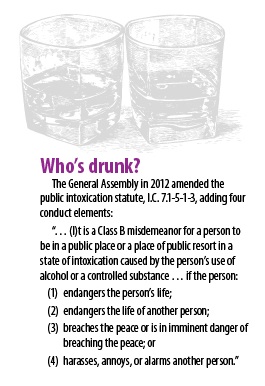Subscriber Benefit
As a subscriber you can listen to articles at work, in the car, or while you work out. Subscribe NowConvictions for public intoxication don’t just require being pickled in public anymore. An inebriated person now has to do something else, but conduct elements added to the criminal statute in 2012 have blurred what constitutes a misdemeanor.
On Sept. 18, Deputy Attorney General George Sherman conceded when pressed by Indiana Supreme Court Justice Brent Dickson during oral argument that a portion of the public intoxication statute as amended likely wouldn’t survive a facial constitutional challenge.
The issue before the court in Rodregus Morgan v. State of Indiana, 49S02-1405-CR-325, is whether a loaded person’s behavior that “annoys” another person is unconstitutionally vague, as the Indiana Court of Appeals ruled.
That’s part of the conduct elements amended into I.C. 7-1-5-1-3. For a public intoxication conviction to stick, a defendant must endanger himself or another; breach the peace or be in imminent danger of breaching the peace; or harass, alarm or annoy another person.
Sherman said the statute as written probably wouldn’t pass constitutional scrutiny for its “annoys” language, but he urged the court to write into Indiana Code a “reasonable person” standard that would allow the court to affirm Morgan’s conviction.
Chief Justice Loretta Rush noted the statute doesn’t read as Sherman advocated. Sherman said law enforcement “has to look at (conduct) from the perspective of a reasonable person, and whether a reasonable person would be annoyed by the conduct.”
Morgan was found guilty of public intoxication and disorderly conduct after an Indianapolis police officer roused him from what Sherman described as a drunken stupor. Morgan’s brother had failed to wake him, and Morgan became angry and agitated when he was arrested after police arrived on a welfare check. Police said he smelled of alcohol and initially resisted efforts to wake him, according to the record.
Suzy St. John of the Marion County Public Defender Agency told justices that the Supreme Court of the United States has found for decades that “annoys” is too vague, ruling, “Conduct that annoys one person does not annoy others.” In Morgan’s case, there was no one except the officer who could attest to being annoyed, she argued.
She said another of the statute’s conditions – that someone can be guilty of public intoxication if their behavior “alarms” another – also may be overbroad.
The conduct elements of public intoxication were inserted in the statute for public policy purposes, the Supreme Court noted in Thang v. State, 10 N.E.3d 1256 (Ind. 2014).
“The addition of these elements promotes public policy encouraging inebriated persons to avoid creating dangerous situations by walking, catching a cab, or riding home with a designated driver rather than driving while intoxicated,” the majority in Thang ruled in affirming his trial court conviction.
But the case split the court 3-2, this time on the endangerment element. Thang was intoxicated at a convenience store, and the majority held that a reasonable inference could be drawn from the facts of the case that Thang had driven to the store while drunk, thus endangering himself or others.
But Justices Steven David and Robert Rucker dissented. David concluded, “The majority opinion does not give us clear guidance going forward. And because I believe the State failed to show that Thang endangered himself or another person — beyond its at-best circumstantial showing of intoxicated driving — I therefore vote to reverse the trial court.”
David likewise appeared skeptical about the “annoys” element in Morgan, musing at one point during oral argument whether the preferable course might have been to let Morgan sleep. St. John said that Morgan didn’t contest his disorderly conduct conviction, and she noted that where statutes don’t spell out offenses, local ordinances might prohibit certain conduct, such as sleeping in a public place.
St. John said that Morgan didn’t contest his disorderly conduct conviction, and she noted that where statutes don’t spell out offenses, local ordinances might prohibit certain conduct, such as sleeping in a public place.
Since the addition of the conduct elements, 19 public intoxication convictions have been decided on appeal, eight of which have been reversed, according to an Indiana Lawyer review. Early on, several reversals involved convictions in which the conduct elements weren’t applied, but the interpretation of those four elements has been a factor in more recent reversals.
David Powell, executive director of the Indiana Prosecuting Attorneys Council, said that for several of the conduct elements, “There’s no clear definition of what those terms mean. … We were very concerned about those additional requirements” when the law was passed.
He said the statute handcuffs law enforcement in many cases. A smashed person at a public shopping mall who becomes sick, for instance, might not annoy everyone, but it’s clearly a situation where intervention is warranted. But given such facts, under caselaw since the changes took effect, “law enforcement really won’t get involved,” Powell said. “They might stand there and encourage the person to leave. That’s a real issue,” he said. “Prosecutors are not going to file those cases if they won’t stand up on appeal.”
But Indiana Public Defender Council Executive Director Larry Landis said fewer prosecutions for public intoxication isn’t a bad thing.
“We supported the change,” he said. Under the revised statute, the person who may have had a few too many isn’t punished simply for choosing to stagger home from the bar rather than getting behind the wheel, unless they’re causing some disturbance.
“Why would you arrest them for doing the right thing?” he asked. Still, lawmakers who drafted the conduct elements may have written a law that’s overbroad, Landis said.
“There’s always a challenge when you’re drafting a statute where you want to limit certain conduct. You have to do it in a way that doesn’t throw the net too wide.”
During oral arguments in Morgan, David mentioned North Carolina’s intoxication statute that includes numerous examples of specific behaviors and Tennessee’s statute which requires unreasonable annoyance as potential examples that might dovetail with the Legislature’s intent.
But St. John argued that even a reasonableness test might not save the “annoys” language in the statute. She observed that she would be more annoyed by a bad singer at a karaoke bar than by someone blacked out at a bus shelter. She also said an obnoxious, hammered New England Patriots fan at a sports bar might reasonably annoy Indianapolis Colts fans. That doesn’t make it a crime.
“There’s no universal, hypothetical ‘reasonable’ person when it comes to ‘annoying,’” she said.•
Please enable JavaScript to view this content.

